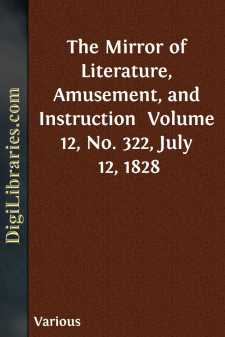Categories
- Antiques & Collectibles 13
- Architecture 36
- Art 48
- Bibles 22
- Biography & Autobiography 813
- Body, Mind & Spirit 142
- Business & Economics 28
- Children's Books 17
- Children's Fiction 14
- Computers 4
- Cooking 94
- Crafts & Hobbies 4
- Drama 346
- Education 46
- Family & Relationships 57
- Fiction 11829
- Games 19
- Gardening 17
- Health & Fitness 34
- History 1377
- House & Home 1
- Humor 147
- Juvenile Fiction 1873
- Juvenile Nonfiction 202
- Language Arts & Disciplines 88
- Law 16
- Literary Collections 686
- Literary Criticism 179
- Mathematics 13
- Medical 41
- Music 40
- Nature 179
- Non-Classifiable 1768
- Performing Arts 7
- Periodicals 1453
- Philosophy 64
- Photography 2
- Poetry 896
- Political Science 203
- Psychology 42
- Reference 154
- Religion 513
- Science 126
- Self-Help 84
- Social Science 81
- Sports & Recreation 34
- Study Aids 3
- Technology & Engineering 59
- Transportation 23
- Travel 463
- True Crime 29
The Mirror of Literature, Amusement, and Instruction Volume 12, No. 322, July 12, 1828
by: Various
Categories:
Description:
Excerpt
CLARENCE TERRACE, REGENT'S PARK.
CLARENCE TERRACE,
REGENT'S PARK.O mortal man, who livest here,
Do not complain of this thy hard estate.
Thomson's Castle of Indolence.
The annexed continuation of our illustrated ramble in the Regent's Park is named Clarence Terrace, in compliment to the illustrious Lord High Admiral of England. It consists of a centre and two wings, of the Corinthian order, connected by colonnades of the Ilyssus Ionic order, and altogether presents a picturesque display of Grecian architecture. The three stories are a rusticated entrance, or basement; and a Corinthian drawing-room and chamber story; surmounted with an elegant entablature and balustrade. In the details, the spectator cannot fail to admire the boldness and richness of the columns supporting the pediment in the centre, and the classic beauty of the pilasters which decorate the wings.
Clarence Terrace is from the designs of Mr. Decimus Burton, to whose ingenious pencil we are indebted for some of the splendid architectural combinations in this district. The present terrace is, we believe, the smallest in the park, but yields to none in picturesque effect and harmonious design; and the variety of its composition renders it one of the most attractive illustrations of our series. It is likewise worthy of remark, that this portion of the Regent's Park, from its natural beauties, is entitled to the first-rate embellishment of art, inasmuch as the basement of Clarence Terrace commands a "living picture" of extraordinary luxuriance; and from the drawing-room windows the lake may be seen studded with little islands, and environed with lawny slopes and unusual park-like vegetation:
With Nature the creating pencil vies
With Nature joyous at the mimic strife.
We have already indulged our fancy in anticipations of the future splendour of the Regent's Park. As yet, art triumphs, and here the lordlings of wealth may enjoy otium cum dignitate: but in a few years Nature may enable this domain to vie with Daphne of old, and become to London what Daphne was to Antioch, whose voluptuousness and luxury are perpetuated in history. But the beginnings of such triumphs furnish more pleasing reflections than their decline.
Clarence Terrace is on the western side of the park, and adjoins Sussex Place, whose cupola tops were the signals for critical censure and ridicule among the first structures in this quarter. The artists have, however, profited by the lesson, and the architecture of the Regent's Park bids fair to rank among the proudest successes of art.
(For the Mirror.)
How ancient the division of parishes is, may at present be difficult to ascertain. Mr. Camden says, England was divided into parishes by Archbishop Honorius, about the year 630. Sir Henry Hobart lays it down, that parishes were first erected by the council of Lateran, which was held A.D. 1179. Each widely differs from the other, and both of them perhaps from the truth, which will probably be found in the medium, between the two extremes....












